Цинский регионализм на пограничье Центральной Азии во второй половине XVIII в.: влияние джунгарского наследия
DOI:
https://doi.org/10.21638/spbu13.2022.310Аннотация
Статья входит в число исследований, посвященных различным областям пограничья Центральной Азии. Эта тема актуальна в связи с изменениями геополитической обстановки в Евразии. Рассматриваются причины и процессы формирования некоторых особенностей цинского регионализма в пограничных регионах империи во второй половине XVIII в. Для Цинской империи овладение территориями, которые в китайских исторических материалах именовались как Си юй (Западный край), имело огромное политическое значение, а приобретенные владения, граничащие со Средней Азией, были преобразованы в административно-территориальную единицу империи, которая стала именоваться Синьцзян (Новая граница). Подчеркивается важность изучения особенностей управления пограничными регионами Цин в Центральной Азии, где активно применялись различные подходы в пограничных отношениях, перенятые от кочевников. Так, раскрываются отличительные черты цинского регионализма, проявившиеся при управлении этой территорией: военная оккупация, учреждение новой административной структуры и издание письменных памятников на языках империи Цин. Применяя более гибкий подход, чем их китайские предшественники, маньчжурские элиты разработали институты и политику управления границами, отличные от тех, которые существовали в предыдущих династиях, и тем самым осуществили гораздо более амбициозную программу верховной власти Цин.
Ключевые слова:
империя Цин, Джунгарское ханство, Алтышар, письменные памятники, Центральная Азия, кочевники
Скачивания
Библиографические ссылки
Загрузки
Опубликован
Как цитировать
Выпуск
Раздел
Лицензия
Статьи журнала «Вестник Санкт-Петербургского университета. Востоковедение и африканистика» находятся в открытом доступе и распространяются в соответствии с условиями Лицензионного Договора с Санкт-Петербургским государственным университетом, который бесплатно предоставляет авторам неограниченное распространение и самостоятельное архивирование.





